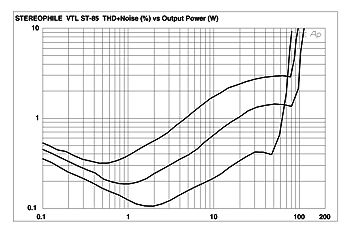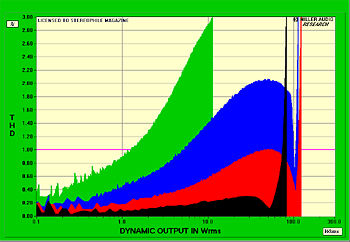| Columns Retired Columns & Blogs |
VTL ST-85 power amplifier Measurements part 3
The THD+noise percentage vs output power results at 1kHz are shown in fig.8, with one channel driven. The discrete clipping measurements are shown in Table 1. The results are shown for 3% THD+noise, since that is the distortion level at which VTL rates the ST-85's power. The output is just a little short of its rating with both channels driven into 4 ohms, but exceeds the spec with one channel driven.

Fig.8 VTL ST-85, distortion (%) vs continuous output power into (from bottom to top): 8 ohms, 4 ohms, 2 ohms.
| Table 1 VTL ST-85 Clipping (3% THD+noise at 1kHz) | |||
| Both Channels Driven W (dBW) | One Channel Driven W (dBW) | ||
| Load/ohms | (L) | (R) | (L) |
| 8 | 63.3 (18) | 64 (18.1) | 72 (18.6) |
| (line) | 119V | 119V | 120V |
| 4 | 78.6 (15.9) | 77.5 (15.9) | 95 (16.8) |
| (line) | 119V | 118V | 119V |
| 2 | 75.4 (12.8) | ||
| (line) | 119V | ||
JA repeated this test using a 20% duty-cycle 1kHz toneburst and the Miller Audio Research Amplifier Profiler. The results are shown in fig.9. The lowest distortion is exhibited into 8 ohms (black trace), though the highest power is developed into 4 ohms (red trace, 50.7W for 1% THD+N, 121.75W for 3% THD+N). The little VTL, however, is not happy driving loads lower than 4 ohms, with high levels of distortion apparent even at low powers in to 2 ohms and 1 ohm (blue and green traces, respectively).

Fig.9 VTL ST-85, distortion (%) vs burst output power into (from bottom to top): 8 ohms (black trace), 4 ohms (red), 2 ohms (blue) and 1 ohm (green).
While none of these results is exceptional, they are respectable for what is, in today's market, a moderately priced tube amplifier.—Thomas J. Norton
- Log in or register to post comments



































